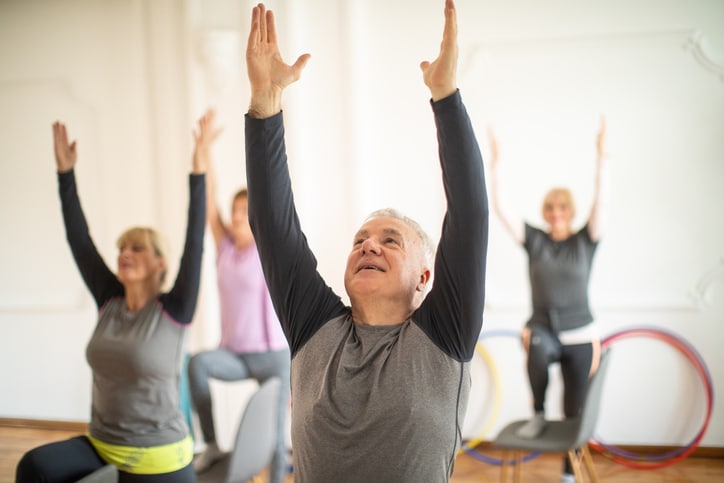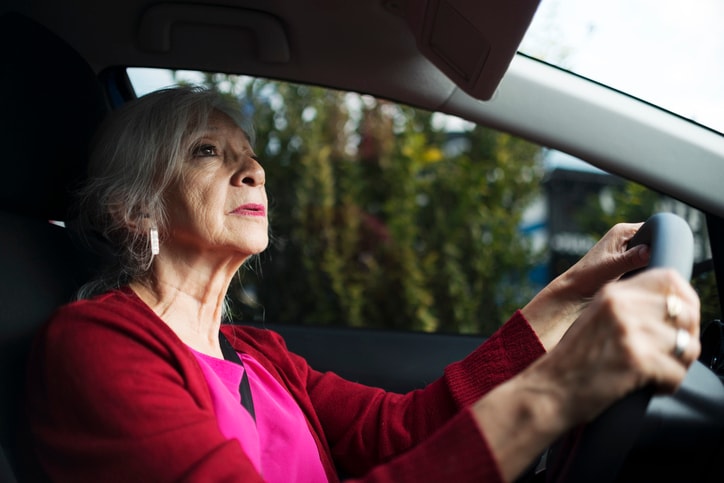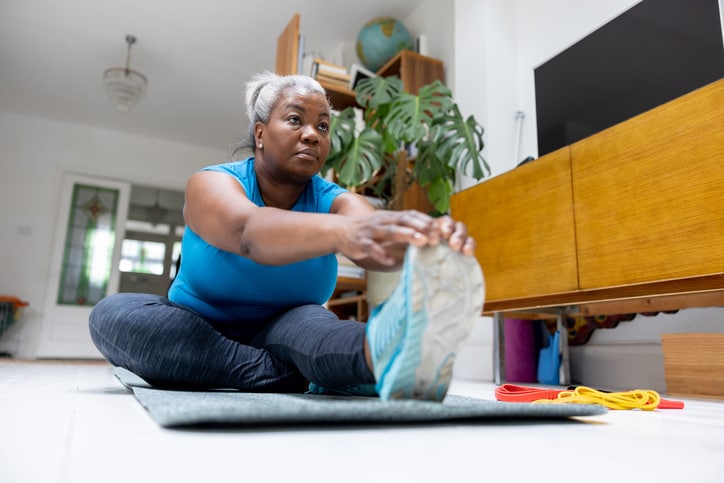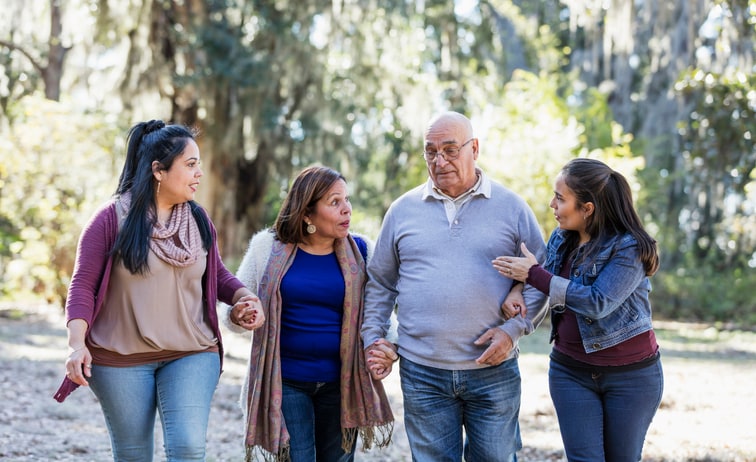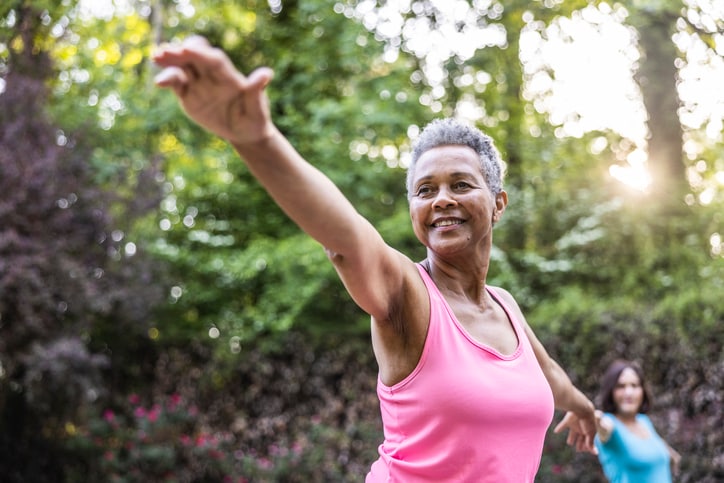When Donna F. Brown, a retired nurse and certified yoga teacher, moved to Pearce, Arizona — a small community with a population of just over 2,000 — her options for practicing yoga were limited. Fortunately, there was a chair yoga class for seniors.
“I attended the class mainly to see what this class had to offer,” she says. “As a yoga teacher, I had previously tried every other yoga class from Bikram to Ashtanga, and everything in between, except for chair. I truly enjoyed the class, and much to my surprise, I got a really good workout!” Soon after, the teaching position opened up. Brown loved the class so much she became the instructor.
Chair yoga is a form of gentle yoga that involves seated postures, and sometimes, standing postures that use a chair for balance. “[It’s] a great way for seniors to safely and effectively engage in and benefit from the ancient practice,” says exercise physiologist and strength coach Tom Holland, who holds a master’s degree in exercise science and sports psychology. “The chair provides safety and stability while allowing seniors to perform elements of yoga that they might not be comfortable doing on the floor.”
Chair yoga involves many of the same postures and movements as freestanding yoga — but with more support — and offers many of the same benefits. Before encouraging a senior loved one or client to try senior chair yoga, though, there are a few safety precautions to note. Here’s everything seniors, caregivers or family members should know about chair yoga for seniors, including how to help someone get started.
Benefits of chair yoga for seniors
“Chair yoga can provide a simple, accessible option that can meaningfully impact a person’s overall well-being,” says Laura Herman, a certified nurses aide and dementia care specialist at Safer Senior Care, who’s worked in senior care for 25 years. It can be easily adapted to suit various mobility levels, done in the comfort and convenience of home, and without costing much (if any) money.
“Regular practice of chair yoga provides many of the same health benefits as regular yoga,” Brown says. These benefits can be especially helpful for seniors due to the way our bodies change as we get older.
“As we age, we experience numerous negative physiological issues including sarcopenia, the gradual loss of muscle mass, which can significantly decrease our functional strength and our quality of life,” Holland explains. “Our balance and flexibility also diminish with age, which can result in falls, broken bones, and more. Yoga can help slow the progression of all of these negative age-related physiological changes, potentially helping seniors increase their lifespan as well as the quality of those years.”
Research backs this up: An April 2019 systematic review of research published in the International Journal of Behavioral Nutrition and Physical Activity found that yoga improves multiple markers of physical function and overall health-related quality of life in older adults.
What, exactly, can you gain from chair yoga? Here are some of the demonstrated benefits.
“Chair yoga can provide a simple, accessible option that can meaningfully impact a person’s overall well-being.”
—Laura Herman, a certified nurses aide and dementia care specialist at Safer Senior Care
Improved muscle strength, balance and flexibility
Yoga can help increase functional strength, balance and flexibility, Holland says. The 2019 research review concluded that yoga can help improve balance, flexibility and lower limb strength, while another small study published in Topics in Geriatric Rehabilitation found that chair yoga significantly improves handgrip strength, upper-body strength, lower-body strength and static and dynamic balance. All of these skills help seniors continue to move safely and independently.
Reduced chronic pain
Chair yoga can also help reduce chronic pain, Brown says. A 2016 study published in the Journal of the American Geriatrics Society found that doing 45 minutes of chair yoga twice weekly for eight weeks helped reduce joint pain in older adults with osteoarthritis. Even better? The effect lasted three months after the yoga program ended.
Better mental health and sleep
The 2019 research review also linked yoga with improvements in perceived mental health, depression, sleep quality and vitality in older adults. Amy Morrison, a certified chair yoga instructor at the Cancer Support Community Indiana in Indianapolis, adds that one of her class members who’s dealt with breast cancer says the class has also been a huge help emotionally.
And for older adults who live with dementia (about 10% of that population, according to a study by Columbia University), regular physical activity, like chair yoga, can promote healthy sleep and emotional well-being, adds Herman. “When people with dementia feel better, they think and function better and tend to have fewer challenges with mood and behavior,” she says.
Social connection
Morrison says her chair yoga class participants have real camaraderie. They even do lunches after class once a month and will miss each other when they’re not in class.
The community aspect and social connections provided by an in-person or live virtual yoga class are highly beneficial and shouldn’t be overlooked, Holland says, as there’s “extensive research into the power of social relationships and longevity.”
For example, a 2010 meta-analysis published in PLoS Medicine looked at 148 studies and found that strong social connections boost “chances of survival” by 50%, meaning they help extend your life. Other research shows that that effect is even more significant among older adults.
How chair yoga compares to freestanding yoga for seniors
Some seniors may be able to do traditional freestanding yoga on a mat, without a chair. “If you’re a healthy, active senior who is still relatively strong and free from any major physiological issues, freestanding yoga might be the choice for you,” Holland says. “[But] if balance and coordination are issues you are currently dealing with, chair yoga is the smartest choice.”
When in doubt, choose chair yoga, and you or your older loved one can build up to a freestanding practice with the help of an instructor. There’s no such thing as being “too good” for chair yoga, either. Brown says that some of her class attendees are capable of practicing freestanding yoga, but choose to come to her chair yoga class, too.
How seniors can get started with chair yoga
“It is best to take your first chair yoga class with an experienced instructor specializing in the senior population,” Holland says. You can also check to see if an instructor has a certification in chair yoga, specifically.
Many community centers (especially in places like nursing homes or medical care facilities) offer chair yoga for seniors that’s either free or heavily discounted. If you or your older loved one can’t make it to a class in person, there are also free classes online, such as on YouTube.
“There are tons of great, easy-to-follow, simple videos online, which means that there are no financial barriers to getting started,” Herman says. You can also find a teacher, like Morrison, who leads live classes virtually — a good option to enhance compliance, motivation, and socialization needs at the same time, according to Herman.
If you’re or your older loved one is going to do chair yoga at home, just make sure you have a sturdy chair without arms and a flat surface to place it on, Morrison says. You might also want a blanket or pillow to help make you comfortable during Savasana, the final resting pose. Yoga is traditionally practiced with bare feet, but seniors may also like to wear a pair of grippy socks to help keep their feet warm without any risk of slipping.
Chair yoga safety tips for seniors
A few must-knows, according to the experts we spoke to.
Get clearance from a doctor
Before beginning, be sure you or your senior loved one gets the green light from a medical professional. “Check with your doctor before attending class to ensure that doing yoga is safe to practice for any chronic physical or mental health condition you have,” Brown says.
Tell the instructor about any health issues
If you or your older loved one deals with any chronic conditions or have any injuries or pain, you should let your instructor know before starting. “I also have medical history forms available for my new students to alert me to any health issues they have so I can offer appropriate adjustments,” Brown says.
Come with an open mind
Open yourself up to all the physical, mental and emotional benefits yoga offers. Remember that the practice is more than just movement, Morrison says, and that your focus should be on how things feel for you, not what anyone else is doing.
Listen to your body
“You need to do what your body needs and it might be totally different today than it was last week, and that’s OK,” Morrison says.
And if anything doesn’t feel right, back off. “If any pose feels painful, then immediately come out of the pose,” Brown adds. “I also remind my students that the chair is there for their protection. Any time students feel unstable when doing the poses, they always have the option to either hold onto the chair or to sit at any time.”
How often should seniors do chair yoga?
Research demonstrates the safety and benefits of doing chair yoga twice a week, for about 45 minutes each session, but that’s certainly not the maximum. Seniors may be able to do chair yoga every day at the direction of their doctor or another medical professional.
For seniors who are still pretty mobile, it’s also a good idea to mix it up rather than doing only chair yoga. “While yoga has myriad benefits, both physiologically as well as psychologically, engaging in a variety of movement modalities such as walking, swimming, dancing and more will confer the greatest health benefits,” Holland says.
Senior chair yoga poses to try
To get a taste of what a chair yoga practice might look like, check out these five poses, which Morrison includes in all her chair yoga classes after a full-body warm-up. There are numerous ways to modify each one of these poses, so if you can’t realize the full expression as shown below by Morrison, know that an instructor can help you find the version of the pose suited for you or your older loved one.
Sitting Mountain
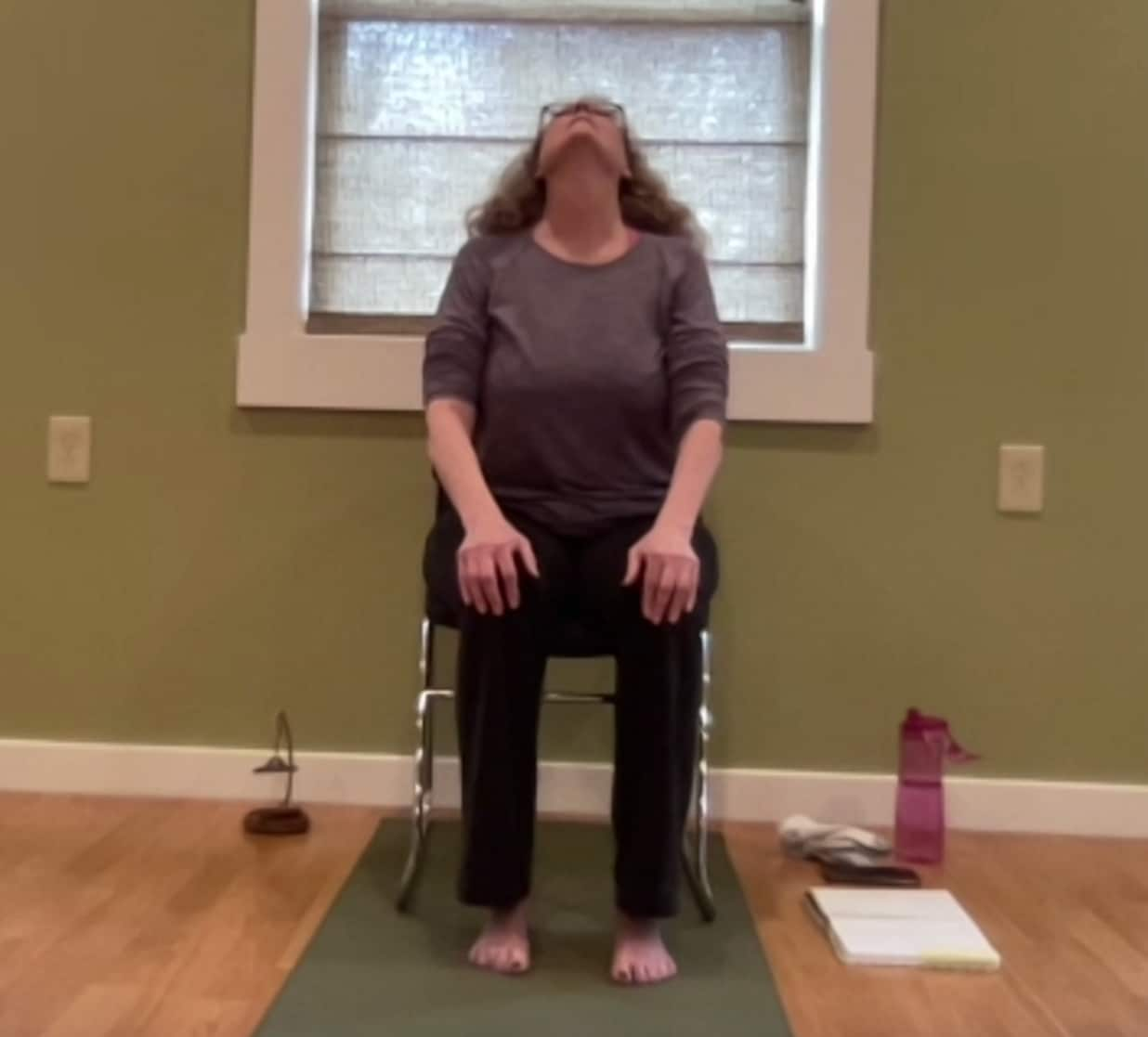
Sit on a chair with your feet flat on the floor and knees bent at 90 degrees. Place your hands on your thighs and extend the crown of your head toward the ceiling. Think about stacking your shoulders and head directly over your hips, with your spine long and core engaged. Hold for three belly breaths.
Cat Cow
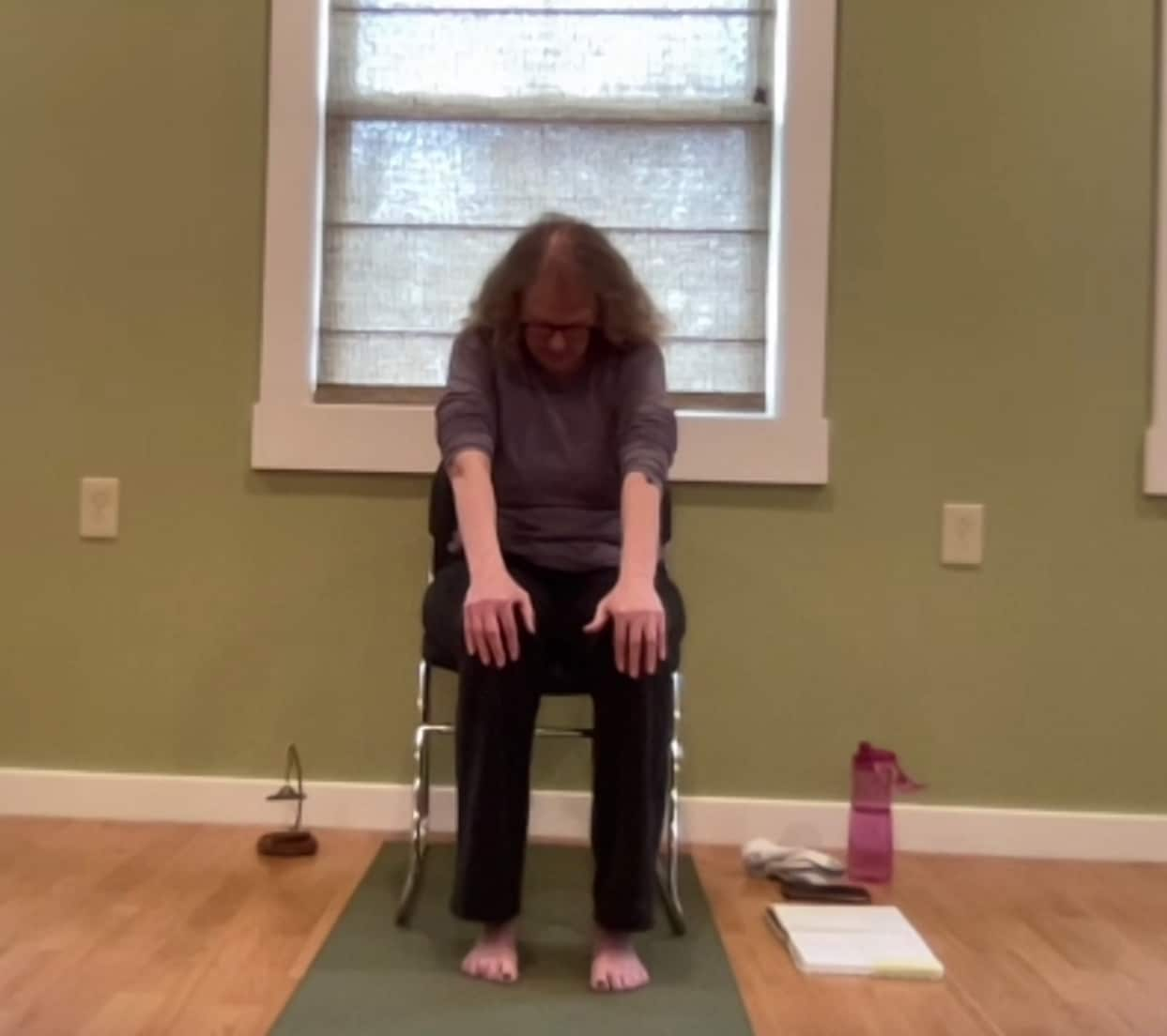
Start in Sitting Mountain, with your hands on your knees. Inhale and slowly arch your back, pulling your chest forward and gently dropping your head backward. This is Cow. Exhale and slowly pull your belly button toward the back of the chair, rounding your back and allowing your head to fold forward. This is Cat. Repeat for three or four breaths.
Tree
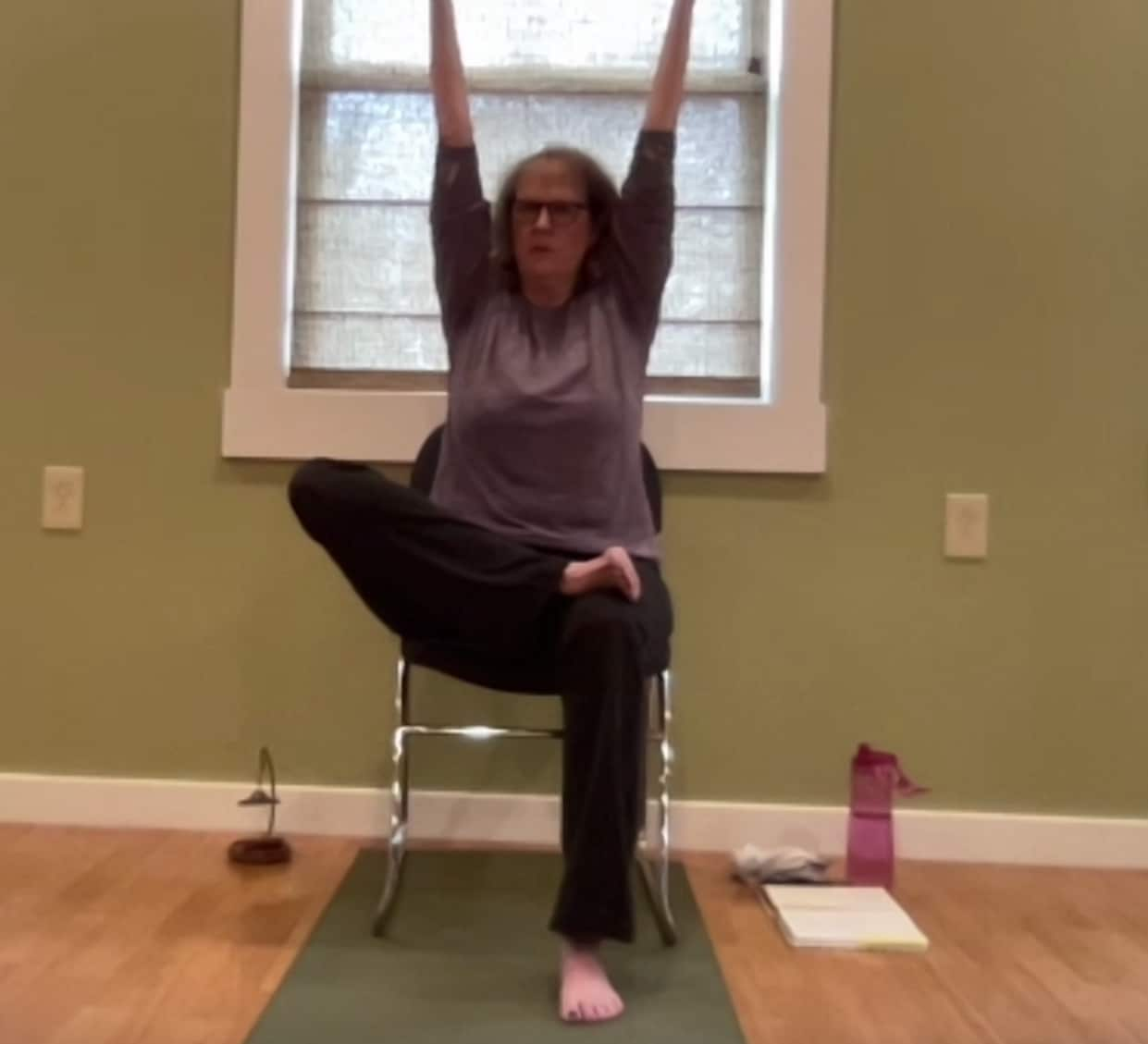
From Sitting Mountain, gently lift the left foot off the floor and cross your left foot over your right thigh, allowing your left knee to fall open. Keep your left foot flexed and your spine tall. Keep your hands resting on your thighs, bring them up to a prayer position in front of your chest, or extend them overhead. Hold for three breaths. Release the pose slowly, starting with your upper body, then repeat on the opposite side.
Peaceful Warrior
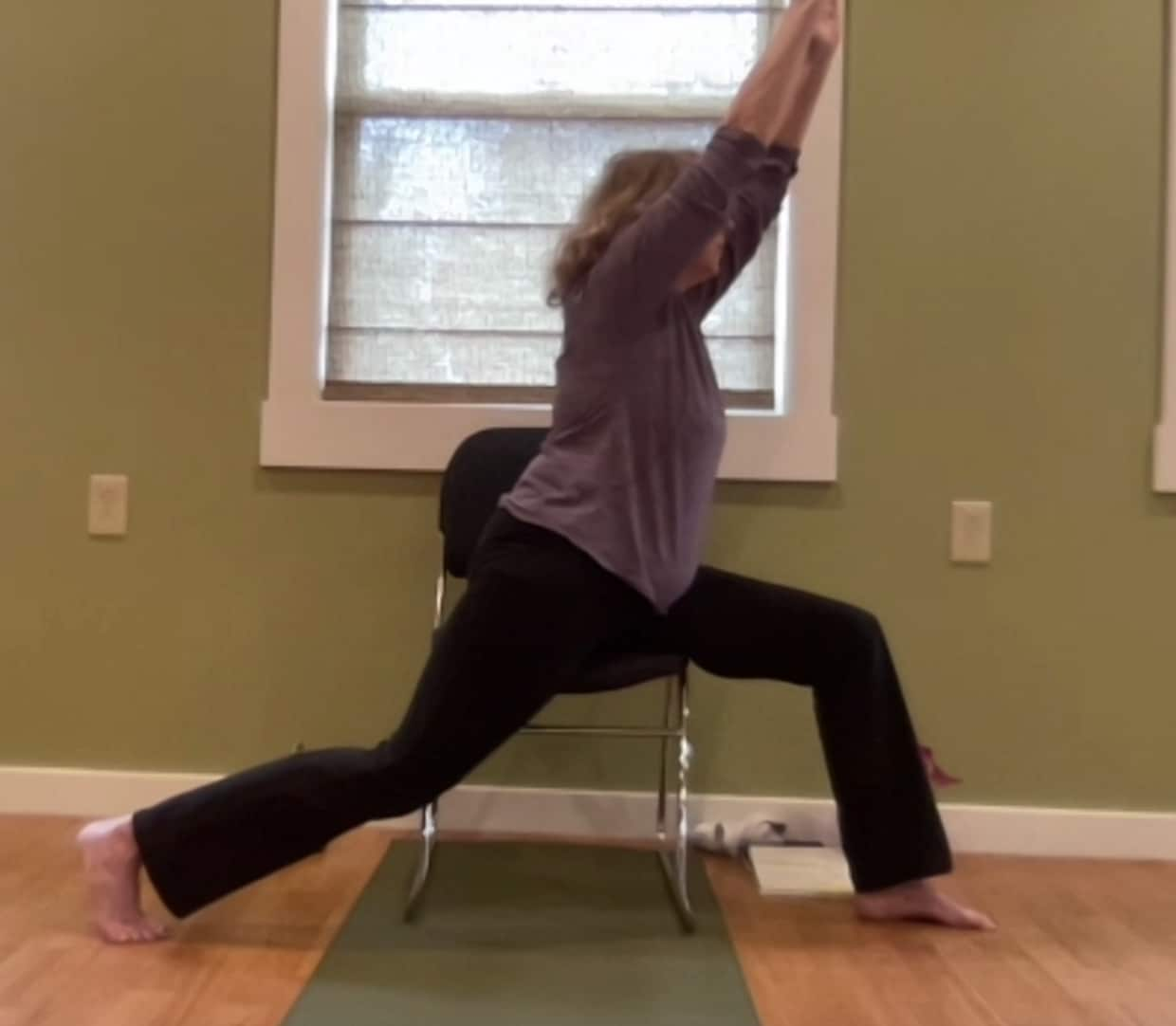
Carefully turn to face the left side of chair, so your left leg is closer to the back of the chair and your right leg is closer to the front. Ground your left foot into the floor, then slowly extend your right leg behind you, knee pointing toward the floor, keeping your weight on the chair. Allow your hands to rest on your front thigh, bring them up to a prayer position in front of your chest, or extend them overhead. Hold for three breaths. Release the pose slowly, starting with your upper body, then repeat on the opposite side.
Proud Warrior
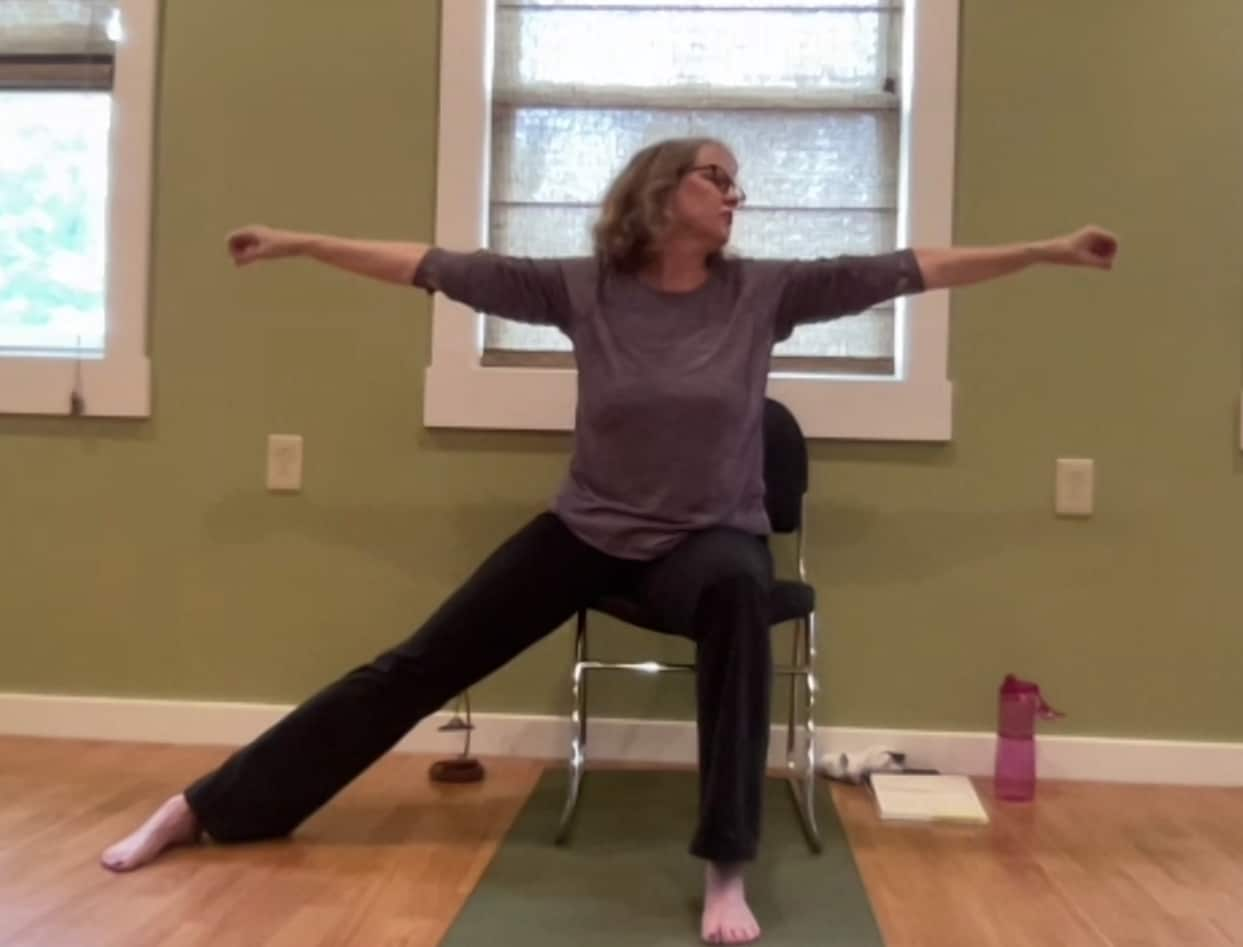
Start in Sitting Mountain. Ground your left foot onto the floor, then slowly extend the right foot out to the side, trying to keep your toes facing forward and your foot flat on the floor. Rest your hands on your front thigh, bring them up to a prayer position in front of your chest, or extend them out to the sides at shoulder height. Keeping your spine long and shoulders pointing forward, turn your head to gaze over your left hand. Hold for three breaths. Release the pose slowly, starting with your upper body, then repeat on the opposite side.
Side Angle
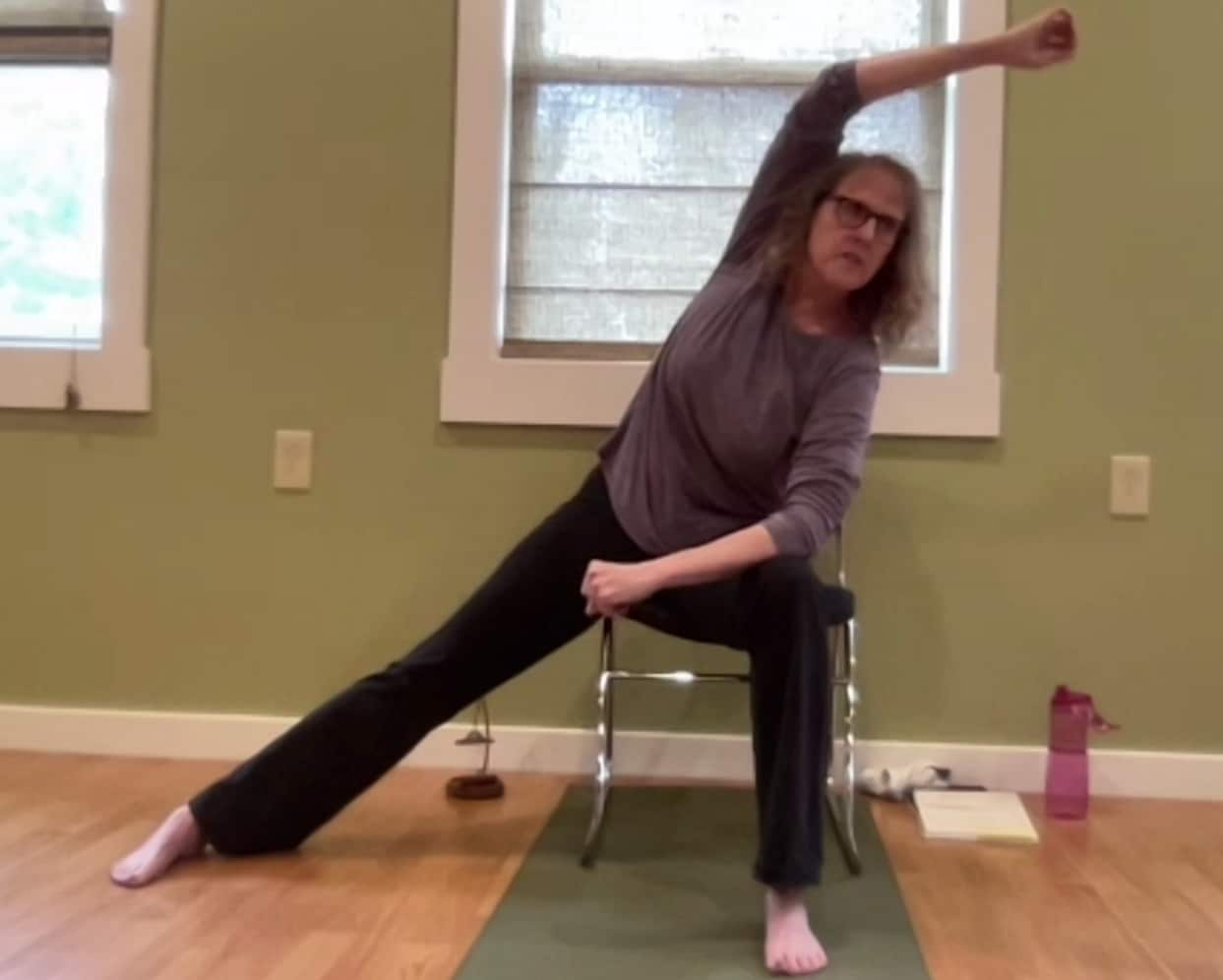
Start in Sitting Mountain. Ground your left foot onto the floor, then slowly extend the right foot out to the side, trying to keep your toes facing forward and your foot flat on the floor. If possible, lower your left elbow onto your left thigh, and extend the right arm overhead, reaching it up and to the left, so you feel a stretch along the right side of your body. Hold for three breaths. Release the pose slowly, starting with your upper body, then repeat on the opposite side.
The bottom line on chair yoga for seniors
“Chair yoga offers a simple, fun and effective way for older adults to engage in regular physical activity — something that’s crucial to overall well-being,” Herman says. The practice comes with plenty of mind-body benefits and with a very low bar of entry.
Getting started can be as simple as finding a beginner chair yoga class on YouTube or Googling “chair yoga for seniors near me.” Whether you’re looking to help an older relative stay active or you’re researching for yourself, one thing’s for sure: Chair yoga is a pretty good bet.
